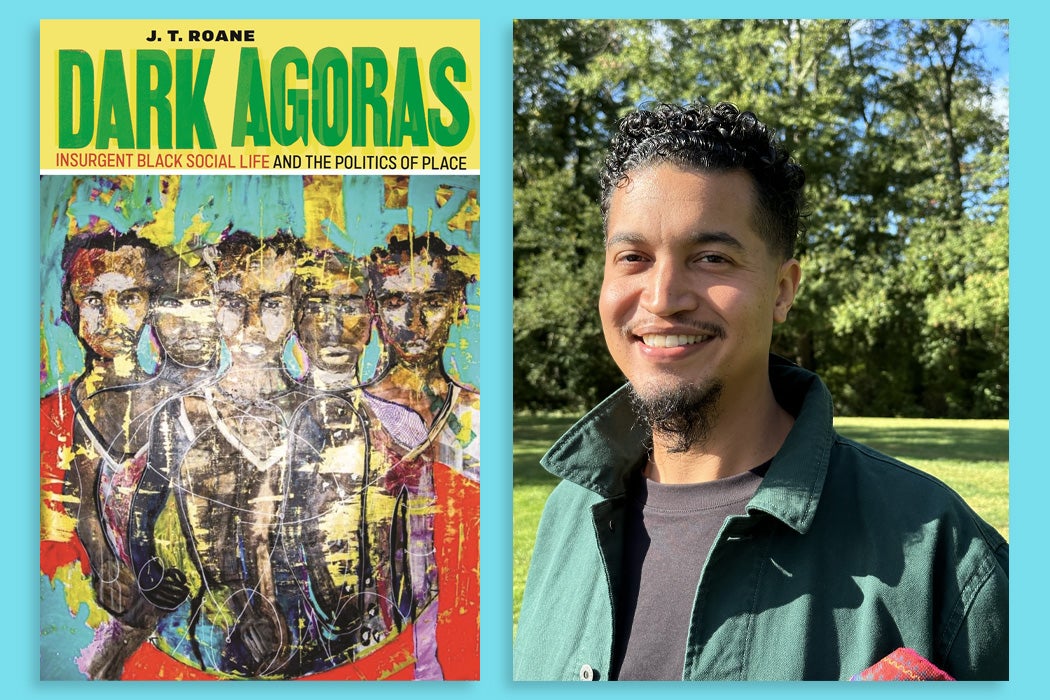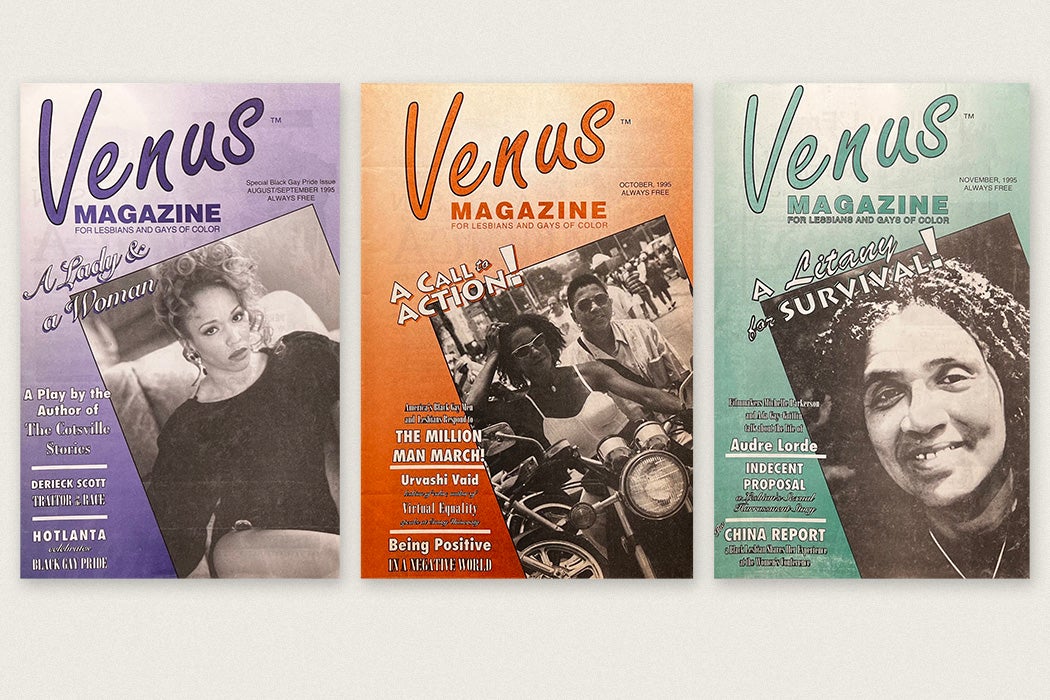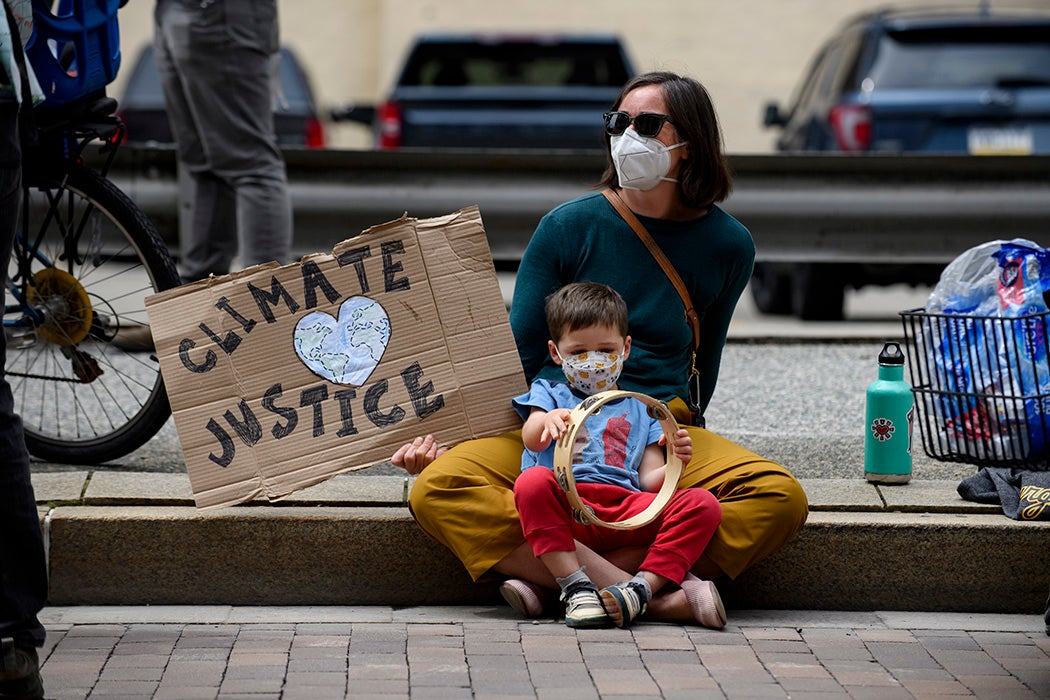Though still in the relatively early stages of his academic career, historian J.T. Roane has already made an impact with his investigations into Black Ecologies, an interdisciplinary field of thought that explores the historical and contemporary relationships between Black people, land, and the environment. It examines how the knowledge emerging from those relationships fuels insurgent, liberatory practices. As Roane argues, Black Ecologies offer counternarratives to mainstream understanding of concepts like climate change and the Anthropocene Era, both of which obscure the effects of racial capitalist violence and extraction that emerged through plantation slavery and that are still intact.
An assistant professor of Africana Studies at Rutgers University, Roane published Dark Agoras: Insurgent Black Social Life and the Politics of Place in 2023 and is now at work on the tentatively titled Practical Prophet, an examination of the Black feminist writer June Jordan. Also a film-maker, he endeavors to unearth the rich and long-standing environmental and ecological thought in Black everyday life and survival, from the plantation to contemporary urban landscapes. This conversation has been edited for length and clarity.
How has the field of Black Ecologies expanded since the phrase was first introduced by Nathan Hare in his essay “Black Ecology?”
Hare’s essay from The Black Scholar is part of a special issue about Black people in urban contexts. He says that white environmental movements ignore the social conditions of Black life, and therefore miss the all-encompassing power of what the study of ecology could be and mean as a critical discourse.
We’ve been building from that—I’m referring to Justin Hosbey, Teona Williams, Danielle Purifoy, Jayson Porter, and others—as a way of naming the radical vulnerability of Black communities across the diaspora and Black(ened) communities. I’m talking about folks who face a structural positioning that is akin to and emerges from the genealogies of plantation extraction and disposability, even if they’re not necessarily or straightforwardly descendants of the African continent. Alongside environmental justice movements more broadly, Black Ecologies also names the ways of knowing that emerge when engaging communities at the ecological margins, taking seriously their visions for futurity and survivability in the face of disaster, and examining how this is reflected through Black expressive cultures and everyday social life.
Black Ecologies do a kind of agitative work against the enclosures that come out of euphemisms and mainstream discourses like green liberalism, the greenwashing of capitalism, and other terminologies that dissociate the histories of violence and extraction that emerge with the plantation and the slave trade and that continue to be alive in the literal air, which Christina Sharpe and others have pointed out.
Black Ecologies is an awkward name for a lot of people, particularly in the era of Anthropocene discourse that often reinforces a kind of global singularity. Naming specificity is often considered as beside the point in relation to white visions of environmental issues.
What do Black Ecologies offer in the face of climate and other catastrophes?
One thing about climate catastrophe is that there’s no return, right, to an Edenic sense of the Earth. But, if we look in the archives of the Black radical tradition for example, we see where communities across the diaspora have created a possibility for kinship and collectivity that illustrates the power and possibility of Black Ecologies. In a very practical sense of: how do we eat? How do we grow food? How do we share food? Those kinds of basic mutual aid practices that have underwritten life across contexts from slavery to contemporary modes of survival offer a roadmap to responding to our current conditions and building a future. This is not to romanticize these practices either; survival at the edge is not cute, but it does speak to the possibilities of living through catastrophe.
Weekly Newsletter
In a theoretical sense, various kinds of Black liberatory and left projects are replete with ecologically insurgent knowledge that we need to return to and understand better. There’s still an underexamined trajectory within Civil Rights, within Black Power in the US context, within Pan-Africanism, where the social metabolism of human existence and its effects on territory, land, and water has been a central inquiry. We’ve been isolated out of being central theorists in environmental humanities and environmental social sciences in the same way matters of social existence, like politics and housing, have been separated from questions of the environment, as if how we live and where we live aren’t environmental concerns. Yet, the Black radical tradition has an abundance of theoretical tools to offer that are grounded in material context. There’s no essential Black relationship to ecologies that’s fully liberatory, but we have a rich tradition of survival and ecological envisioning that we should call on.
We might turn to June Jordan who was an environmental planning-oriented person as much as a poet. Or, we might look at the ordinary ways that the blues, for example, has historically documented disaster. We could also consider enslaved people in the Caribbean and the US and their incendiary politics around burning on plantations as means of trying to erect a new environmental order, if we’re thinking openly about how Black Ecology shows up differently than white conservationism and its genealogy, which is colonial. The genealogy of carbon counting, for example, or simply exchanging energetics of the global order, one mode for another, without fundamentally disrupting extraction and disposability comes out of a colonial genealogy of managing the earth and its resources—squeeze them, but don’t vanquish them so that you can maintain future prospects of further exploitation. Black Ecologies has its own logics that belie that genealogy.
Let’s talk about Dark Agoras: Insurgent Black Social Life and the Politics of Place? What were you exploring in it?
I trace the social worlds and alternative spatial formulations that Black communities created in the context of plantation slavery, particularly in the upper south. I also examine, across the disruptions of the internal slave trade from Virginia and into Louisiana and the Old Southwest frontier, the ways enslaved people held on to a basic social spatial order at the edges of plantation life. I refer to this as the plot, which has various iterations—from visions of plotting associated with insurrection and rebellion to the quotidian uses of the plot as a site of gardening and enslaved burial grounds. Broadly, it refers to the ways that Black communities use value and other forms of value in ways that exceed land and people as property.
After emancipation, those communities that had these visions and alternative practices that emerged at the edges of the plantation, were able to realize many of those visions in place because of the disruptions of war and their own efforts to transform those landscapes. This was the basis of how plotting could be a liberatory landscape in the aftermath of slavery. Between the 1890s and the early 1920s, when Jim Crow pushed large numbers of Black communities off the land, people took those visions forward. But the question emerges, how do you take forward visions for alternative worlds that were based in land when you can’t take land with you?
In early great migration, the Black working-class formulations that materialized coming out of the same ethos as the plot—a vision of stolen time and stolen place—are what I categorize as the underground (considered disreputable economically and socially) and the set apart (considered holy/associated with forms of religious sanctity like the Nation of Islam and other non-Christian organizations). Those two categorizations were indistinguishable during slavery; enslaved people going between plantations in the middle of the night to seek loved ones, go to parties, or attend religious services existed interchangeably as a singular mode. In the context of the city, especially following the violent displacements associated with Jim Crow, those formulations were cleaved. Though the underground and the set apart were often diametrically opposed, there was a lot of literal movement between them. In the book, I consider Philadelphia-based folks who engaged that movement between these two spaces and also examine what happened when those worlds came together, particularly how it shaped politics from the interwar period in the 1940s with Father Divine and the Peace Mission to MOVE in the 1970s.
You dedicate your book to your father, Earl Roane; you describe him as an organic historian from whom you gain your writing power. How does your connection to your home of Tappahannock, Virginia shape your work?
My father could tell you all kinds of information from who was the biggest Black landowner to who was murdered where—a kind of baron of oral tradition. That oral tradition and transmission of information, especially in a place like rural Virginia, is ongoingly critical to Black expressive life and culture. My father wasn’t formally educated, but being able to translate some of that energy into the written form is where I get a lot of information and power. Much of the book is deeply personal—my interest in Philadelphia is rooted in my family’s migration from the south to Philly and South Jersey. Those histories are embedded throughout what I think about.
You edited Black Perspectives and have curated numerous projects since then. What informs your editorial perspective?
My perspective was shaped in a particular context through my undergraduate training at the University of Virginia. My politicization happened during my sophomore year in 2005 around the time of Hurricane Katrina. In early 2006, Claudrena Harold was planning a benefit for ex-Panthers and jazz musicians displaced by the storm, and I was drawn into that work. Claudrena introduced me to a model and vision of Black studies that was about mobilization, and I’ve modeled my career after her in many ways. In addition to being an author and historian on Garveyism and other New Negro Formations in the South (with a new book on gospel music), she’s also working on her 12th film, a collaboration with Kevin Everson.
The model of Black studies that I was brought under was about training people to where they could go be anything in the world and maintain that Black studies understanding/framework. You could be a physician. A social worker. It wasn’t a model where you were necessarily trying to reproduce other academics. It was about pedagogy in a wider frame. June Jordan is an exemplar of this. From the early 1960s she was always embedded in Black studies discussions, and when she got to Berkeley and started to make Poetry for the People, her vision of Black studies and poetry was about empowering people to do many things, not just to be a poet or Black studies practitioner.
My editorial perspective has been to emphasize the need for all modalities at once—we can’t afford to abandon any modes to our capitalist overlords. We should be making films and interjecting ourselves into public discussions. We should be capacious in how we approach that from a stylistic standpoint but also in terms of theoretical and conceptual frameworks. We need everyone’s power and creativity to transform. That’s the approach I take.
Related Content
From the Black Queer South to the World
Toward Environmental Justice: Key Concepts
Speaking of June Jordan—can you tell us more about your work on her?
I’ve been working with the tentative title—The Practical Prophet. Jordan has this vision of radical transformation, reform, and decolonization that emerges from her day-to-day experiences as a Black woman, feminist, and as the mother of a Black child. From that position, she develops this vision of global transformation that’s a direct hedge from a Black feminist leftist perspective on tyrannical gender, racial capitalist violence, and US militarism.
I started with her earlier writing that began in 1964 when she witnessed the Harlem ‘riots’ (after a white off-duty police officer killed a Black teenager) through 1996 when she drafted the second version of Okay, Now—her unpublished novel about a successful land reform from a plantation to a collectively owned and stewarded project in Mississippi, which she originally started in 1975/1976. I’ve focused on her environmental architectural collaboration with Buckminster Fuller for Sky Rise for Harlem, which followed and served as part of her response to the Harlem riots (scholars Alexis Pauline Gumbs and Cheryl Fish have also written about this). I’ve also focused on her children’s literature from that period, including His Own Where, her first commercially successful project which centers a young Brooklyn-based protagonist named Buddy who organizes the transformation of a Brooklyn neighborhood and does a lot of imaginative work around what the neighborhood could be. She also wrote a children’s book about Buckminster Fuller and another one about Fannie Lou Hamer.
I think of this line of thought as practical prophetics because, although it’s visionary, it’s also grounded in the organic relationships of communities and not romantic, utopic visions. Even in Okay, Now, people aren’t all on one page or moving with the same understanding politically or otherwise. Some people are there because they’re hustling. Other people are there because they believe in the project politically. June Jordan’s writing encompasses intimacy with the intricacies of Black life. She doesn’t romanticize but does try to forward visionary perspectives of what the future might be.









